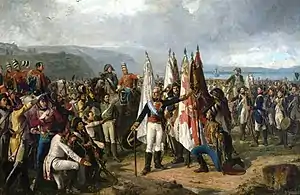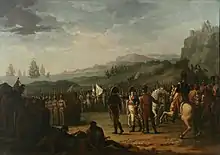Pedro Caro Sureda, 3rd Marquis of La Romana
Pedro Caro Sureda, 3rd Marquis of La Romana (1761–1811) was a Spanish military officer who served with distinction in the French Revolutionary and Peninsular wars.
Pedro Caro Sureda | |
|---|---|
.jpg.webp) 3rd Marquis de La Romana, wearing the uniform of a captain general,[1] with the Grand Cross and band of Order of Charles III and an unidentified decoration (possibly foreign)[note 1] | |
| Born | 2 October 1761 Palma de Mallorca |
| Died | 23 January 1811 (aged 49) Cartaxo, Portugal |
| Allegiance | |
| Battles/wars | Peninsular War |
His two younger brothers, José Caro Sureda (1764–1813),[2] and Juan Caro Sureda (1775–1820)[3] were also military commanders during the Peninsular war.
Biography
Early career
Born at Palma de Mallorca to a family of Balearic nobility, La Romana was educated in Lyon, France. His education was classical; he read Greek and Latin, as well as speaking French and English. He entered the Seminario de Nobles in Madrid and later studied at the University of Salamanca.[4]
Like many Spanish officers of the Napoleonic Wars, La Romana served in the American Revolutionary War in his youth. After entering the military academy in 1775, he reached the rank of frigate captain in 1791. He saw action at Minorca (1781) and at Gibraltar (1782).[4]
In 1793, La Romana transferred to the Infantry Regiment "Inmemorial del Rey" No. 1, serving under his uncle, General Ventura Caro.[4] He saw action in the War of the Pyrenees, part of the War of the First Coalition and was promoted to field marshal in 1794.[4][5]
He then transferred to the Army of Catalonia, serving first under the orders of Luis Firmín de Carvajal, Conde de la Unión and, following Carvajal's death at Black Mountain (1794), under Urrutia.[4]
Following the signing of the Peace of Basel (1795) he was promoted to lieutenant general for his services during that campaign. In 1800 he was appointed Captain General of Catalonia.[4]
King Charles IV, bullied and pressured by Napoleon, agreed in 1807 to provide a veteran infantry division to bolster the French army in Germany. La Romana was made commander of this Division of the North and spent 1807 and 1808 performing garrison duties in Hamburg and later Denmark under Marshal Bernadotte.
Peninsular War


When the Peninsular War broke out, La Romana made plans with the British to repatriate his men to Spain. The success of the evacuation of the La Romana Division was chiefly credited to his subterfuge and resourcefulness. At least 9,000 men of the 15,000-strong division were immediately able to board British ships on 27 August and escape to Spain. Their defection reduced Bernadotte's Hanseatic Army to a string of glorified coastal garrisons, severely sapping Napoleon's left (north) wing in the contest with Austria for mastery over central Europe in 1809.
La Romana arrived at Santander on the Cantabrian front and received command of the Army of Galicia on 11 November. This army, under General Blake, was destroyed in battle that same day. On 26 November, La Romana assumed effective command of what remained of the army – 6,000 men all told.
With this force, he fought some rearguard actions for General Moore's retreat westwards to Corunna. Using his limited means, La Romana conducted small-scale attacks against the French in 1809. These met with success and his men were able to distract the French and overwhelm isolated garrisons such as Villafranca. Following the French defeat at Puente Sanpayo on 6 June, Marshal Soult abandoned his attempts to reestablish French rule in Galicia. When Soult moved against the British on the Portuguese frontier, La Romana drove the French from Asturias as well.
La Romana was appointed to the Central Junta on 29 August and served until 1810. He then returned to military operations under Wellington but died suddenly on 23 January 1811 while preparing the relief of Badajoz. With Castaños, La Romana was the Spanish general most trusted and respected by Wellington.[6] At news of his death, Wellington wrote, "his loss is the greatest which the cause could sustain."[7]
He is credited as being the force behind the construction of the castle at Bendinat.
See also
Notes
- This portrait, by Eduardo Carrió is a copy (c. 1878) of an original by Vicente López (c. 1815). As La Romana died in 1811, López's portrait must have been painted from an effigy. (Museo del Prado.)
References
- (in Spanish). Museo del Prado. "Pedro Caro Sureda, marqués de la Romana (copia)". 17 February 2022. Retrieved 28 April 2023.
- (in Spanish). Martín-Lanuza, Alberto. "José Caro Sureda". Real Academia de la Historia. Retrieved 4 August 2023.
- (in Spanish). Isabel Sánchez, José Luis. "Juan Caro Sureda". Diccionario Biográfico electrónico (DB~e). Real Academia de la Historia. Retrieved 4 August 2023.
- (in Spanish). Casinello Pérez, Andrés. "Pedro Caro Sureda". Diccionario Biográfico electrónico (DB~e). Real Academia de la Historia. Retrieved 28 April 2023.
- Rodriguez, Jose Manuel. "Pedro Caro y Sureda, 3rd Marquis of la Romana". The Napoleon Series. Retrieved 27 August 2010.
- Longford, p. 254.
- Longford, p. 309.
Bibliography
- Chandler, David G. (1995), The Campaigns of Napoleon, Simon & Schuster, ISBN 0-02-523660-1
- Longford, Elizabeth (1969). Wellington: The Years of The Sword. New York: Harper and Row Publishers.